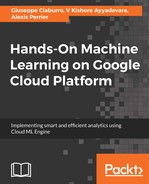ML projects are resource intensive. From storage to computational power, training models sometimes require resources that cannot be found on a simple standalone computer. Physical limitations in terms of storage have shrunk in recent years. As we now enjoy reliable terabyte storage accessible at reduced prices, storage is no longer an issue for most data projects that are not in the realm of big data. Computing power has also increased so much that what required expensive workstations a few years ago can now run on laptops.
However, despite all this amazingly rapid evolution, the power of the standalone PC is finite. There is an upper limit to the volume of data you can store on your machine and to the time you're willing to wait to get your model trained. New frontiers in AI, with speech-to-text, video captioning in real time, self-driving cars, music generation, or chatbots that can fool a human being and pass the turing test, require ever larger resources. This is especially true of deep learning models, which are too slow on standard CPUs and require GPU-based machines to train in a reasonable amount of time.
ML in the cloud does not face these limitations. What you get with cloud computing is direct access to high-performance computing (HPC). Before the cloud (roughly before AWS launched its Elastic Computing Cloud (EC2) service in 2006), HPC was only available via supercomputers, such as the Cray computers. Cray is a US company that has built some of the most powerful supercomputers since the 1960s. China's Tianhe-2 is now the most powerful supercomputer in the world, with a capacity of 100,000 petaflops (that's 102 x 1015, or 10 to the power of 17 floating-point operations per second!).
A supercomputer not only costs millions of US dollars but also requires its own physical infrastructure and has huge maintenance costs. It is also out of reach for individuals and for most companies. Engineers and researchers, hungry for HPC, now turn to on-demand cloud infrastructures. Cloud service offers are democratizing access to HPC.
Computing in the cloud is built on a distributed architecture. The processors are distributed across different servers instead of being aggregated in one single machine. With a few clicks or command lines, anyone can sign up massively complex banks of servers in a matter of minutes. The amount of power at your command can be mind-blowing.
Cloud computing can not only handle the most demanding optimization tasks but also carry out a simple regression on a tiny dataset. Cloud computing is extremely flexible.
To recap, cloud computing offers:
- Instantaneity: Resources can be made available in a matter of minutes.
- On-demand: Instances can be put on stand by or decommissioned when no longer needed.
- Diversity: The wide range of operating systems, storage, and database solutions, allow the architect to create project-focused architectures, from simple mobile applications to ML APIs.
- Unlimited resources: If not infinite yet, the volume of resources for storage computing and networks you can assemble is mind-blowing.
- GPUs: Most PCs are based on CPUs (with the exception of machines optimized for gaming). Deep learning requires GPUs to achieve human-compatible speeds for training models. Cloud computing makes GPUs available at a fraction of the cost needed to buy GPU machines.
- Controlled accessibility and security: With granular role definitions, service compartmentalization, encrypted connections, and user-based access control, cloud platforms greatly reduce the risk of intrusion and data loss.
Apart from these, there are several other types of cloud platforms and offers on the market.
